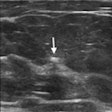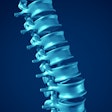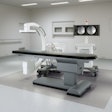Microwave ablation of lung tumors outperforms the more established radiofrequency (RF) ablation technique, according to a new animal study published in Radiology from the University of Wisconsin.
Analysis of gross pathology and CT images found that microwave ablation created larger, more uniform circular zones around ablated regions of normal porcine lungs, improving the chances that the targeted tumor and satellite tumor deposits just outside its periphery would be included in the ablated zone.
Thermal ablation is being used with increasing frequency for treating uresectable lung tumors, both as a primary treatment strategy and as an adjuvant to external radiation, wrote Christopher Brace, Ph.D., and colleagues from the University of Wisconsin's Clinical Sciences Center in Madison.
But RF ablation also comes with daunting technical deficiencies, particularly in the high-impedance path it creates in lung tissue inflated during treatment. The resulting lower energy deposition reduces the temperature to which the ablation zone can be successfully raised, increasing the chances of failed treatment -- and the possibility that satellite tumor deposits just beyond the periphery will be left intact. The use of multipronged electrodes increases impedance in RF ablation, but it also increases the invasiveness of the procedure and the unpredictability of coverage.
In contrast, "microwave energy penetration is not limited by the lower electrical permittivity and conductivity of inflated lung, desiccated tissue, or charred tissue," wrote Brace and his team. "Unlike RF electrodes, microwave antennas do not require the placement of grounding pads, and multiple antennas can be operated simultaneously in close proximity without switching" (Radiology online, March 31, 2009).
Because the two techniques have not been compared, the study sought to evaluate the performance of equivalently sized radiofrequency and microwave ablation applicators in the lungs of eight pigs.
Brace, along with Dr. J. Louis Hinshaw, Paul Laeseke, Ph.D., and colleagues, performed a total of 18 ablations in vivo in the lungs of three female swine following sedation with tiletamine hydrochloride, zolazepam hydrochloride, and anesthesia using 2% inhaled isoflurane.
RF and microwave ablation applicators were placed peripherally in normal porcine lungs by using CT fluoroscopic guidance (LightSpeed Plus, GE Healthcare, Chalfont St. Giles, U.K.). Applicators were used to prevent overlap of ablation zones and to avoid heat sinks (such as large vessels) that might alter the results. Three applicators of each energy type resulted in six ablations per animal.
Ablations were performed for 10 minutes by using either 125 W of microwave power or 200 W of RF power delivered with an impedance-based pulsing algorithm. CT images were acquired every minute during the procedures to monitor growth of the ablated areas.
The RF method was applied via a 17-gauge internally cooled electrode (Cool-tip, Valleylab, Boulder, CO) with 3-cm active length powered by a 200-W generator with impedance-based pulsing. The microwave ablation system consisted of a prototype 17-gauge water-cooled triaxial antenna delivering power from a 2.45-GHz generator with 125-W output (CoberMuegge, Norwalk, CT). The flow rate of the cooling water was approximately 100 mL/min in both systems.
After the experiment, the ablation zones were excised and sectioned transverse to the applicator in 5-mm increments, according to the authors. Measurements of the ablated zones included minimum and maximum diameter, cross-sectional area, length, and circularity from gross specimens and CT images, using a mixed-effects model to compare measurements.
According to the results, mean diameter of the ablated zone was 25% larger with microwave ablation, at 3.32 cm ± 0.19 (standard deviation), versus 2.70 cm ± 0.23, p < 0.001, with RF ablation. The mean cross-sectional area (8.25 cm2 ± 0.92 versus 5.45 cm2 ± 1.14, p < 0.001) was 50% larger with microwave ablation than with RF ablation. With microwave ablation, the zones of ablation were also significantly more circular in cross section (mean circularity, 0.90 ± 0.06 versus 0.82 ± 0.09; p < 0.05).
"Ablation zones achieved with microwave ablation also grew faster than those achieved with RF ablation," they wrote. "Three of nine ablation zones achieved with microwave ablation extended into the body wall, as noted by using attenuation changes on CT images."
All of the animals tolerated the procedure without complications. One small pneumothorax was found during RF ablation, but it stabilized without intervention.
"Our results indicate that microwave ablation by using a high-power generator and cooled-power delivery system outperforms RF ablation for increased ablation zone size and circularity in normal porcine lung," Brace and colleagues wrote. "Measurement variability was also slightly lower with microwave ablation, and this finding may indicate improved repeatability with the use of microwave energy."
The most likely reason for the superior performance of microwave energy is its ability to deliver power continuously over the target volume, they wrote. In contrast, RF power delivery is limited by the intrinsically high impedance of normal lung tissue due to its high air content, a problem that worsens during treatment when charred or desiccated tissue is present.
Based on previous experience showing that microwave ablation creates higher temperatures and a larger core of desiccation compared to RF ablation, and the authors' finding that microwave ablation created a larger zone of low attenuation at CT, "we hypothesize that this zone may relate to tissue desiccation that occurs at high temperatures," the group wrote. "More study is necessary to verify this theory."
The use of normal tissue was a limitation of the study, inasmuch as the properties of lung tumors are different from those of normal parenchyma. Inflated lung tissue has a high electrical impedance for RF energy, a factor that limits the power deposition of current RF systems.
"However, normal lung tissue often completely surrounds tumors and limits RF current flow in the same way as if the electrode were immersed in parenchyma," they wrote. "Therefore, we believe that the use of a normal model for this comparative study was warranted."
High-power microwave ablation using a 17-gauge triaxial antenna appears to create ablation zones that are larger and more circular than those produced by RF ablation systems using applicators of a similar diameter, the group concluded. More research is needed to compare multiple devices in the clinical setting "for a more complete characterization of the pulmonary ablation armamentarium," they wrote.
By Eric Barnes
AuntMinnie.com staff writer
April 17, 2009
Related Reading
Cryoablation highly effective for localized kidney cancer, March 11, 2009
Percutaneous cryoablation feasible for some renal tumors, March 7, 2007
Radiofrequency ablation of lung tumors may extend survival, July 25, 2006
RF ablation gains ground as lung cancer option, January 14, 2005
CT-guided RFA effective for local control and palliation of lung cancer, December 1, 2004
Copyright © 2009 AuntMinnie.com



















